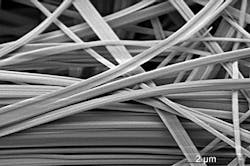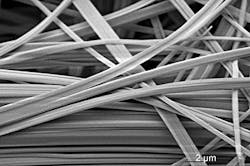Needles Point To Improved Water Splitting
A new needle-like hybrid catalyst offers a route to cheap and sustainable hydrogen production, believe researchers at the Technical University of Munich (TUM), Munich, Germany. They have created a stable yet flexible semiconductor structure they claim splits water four times more efficiently than previously possible. The reaction takes place at ambient temperature and pressure.
The new material consists of a fibrous, inorganic, double-helix compound made of tin, iodine and phosphorus (SnIP) that then is encased in a carbon nitride shell.
The team, led by Tom Nilges, a materials science professor at TUM, and Karthik Shankar, a professor of electrical and computer engineering at the University of Alberta, B.C., found that a 30/70% ratio of SnIP to carbon nitride gave the best catalytic performance. Knowing that a large surface area improves catalytic efficiency, the researchers then split the fibers into thinner needle-like strands, some with diameters of only a few nanometers (Figure 1).
Catalyst synthesis is a simple process that takes place at temperatures of around 400°C, say the researchers; the resulting fibers are both robust and flexible, they add.
Figure 1. Thin strands provide greater surface area and, thus, higher catalytic efficiency for water splitting. Source: TUM.
“We are currently working on lab scale. Upscaling must be realized and stability tests carried out over a longer period of time before any pilot-scale work could be planned,” notes Nilges.
The catalyst’s water-splitting capabilities can be further enhanced, he believes. “We need to adjust the amount of material in the core shell to improve the hydrogen production. This work will last some more years and requires funding.”
The team now is investigating other hybrid materials, including phosphorus/titanium dioxide (TiO2) and SnIP/TiO2, which also show good promise as water splitters.
It already has synthesized hybrid semiconductor/TiO2 nanotube photocatalysts. An upcoming article in ACS Applied Nano Materials will describe a simple low-cost synthesis route that results in loading the cavities in 100-µm-long TiO2 nanotubes with easily accessible fibrous red and black phosphorus.
The researchers then use a vapor transport technique to create heterojunctions (i.e., the interfaces that occur between two layers or regions of dissimilar crystalline semiconductors) between phosphorus and TiO2 that enhance both charge separation and effective visible light absorption — and also give improved water-splitting performance.
These projects effectively demonstrate the conversion efficiencies of nanostructured hybrids, believes Nilges. He foresees potential opportunities in opto-electronic applications such as photodetectors, photovoltaics, photoelectrochemical catalysts and sensors.

